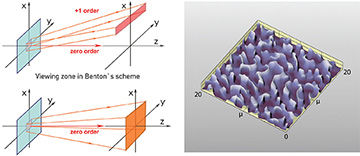 Top left: Benton’s scheme for observing 3D image for a rainbow hologram at first order. Bottom left: New scheme for observation in the vicinity of zero order. Right: Fragment of micro-relief forming 3D zero-order image. [Enlarge figure]
Top left: Benton’s scheme for observing 3D image for a rainbow hologram at first order. Bottom left: New scheme for observation in the vicinity of zero order. Right: Fragment of micro-relief forming 3D zero-order image. [Enlarge figure]
The development of methods for synthesizing flat optical elements to form 3D images began after the work of Denis Gabor, who was awarded the Nobel Prize in physics in 1971 for inventing and developing the holographic recording principle.1 In particular, Gabor’s follower Stephen Benton developed a method for recording rainbow holograms, which form 3D images at the first diffraction order when illuminated by a point source of white light.2
These holograms form a visual 3D parallax in the left–right direction only; when tilted up–down or rotated, the 3D image changes its color and eventually disappears completely. Later, efficient technology for microrelief replication of holograms was invented, and rainbow holograms became widely used for anti-counterfeit protection.3
This year, we proposed a method for computing and synthesizing a nano-optical element to produce a new visual effect: a 3D image formed in the vicinity of zero diffraction order.4 Our method for synthesizing nano-optical elements according to the zero-order scheme consists of five steps: (1) Render frames using a chosen computer 3D model. (2) Split an optical element into elementary regions less than 50 microns in size. (3) Determine the angular radiation patterns for each elementary region using the frames rendered. (4) Numerically solve the inverse problems of finding the phase function of an optical element in each elementary region according to the angular radiation patterns. (5) Record the calculated microrelief of the entire optical element using electron-beam lithography with an accuracy of 10 nm.
The resulting 3D image can be observed well when illuminated by white light, and an observer sees the 3D image with full parallax, both when the optical element is tilted and when it is rotated 360 degrees (see accompanying videos). In addition, unlike rainbow holograms, the color of the formed 3D image does not depend on the viewing angle—in other words, the formed 3D image behaves like a real 3D object. The method also allows fragments of diffraction gratings to be embedded into the nano-optical element to form an additional 2D image visible at an acute angle.
Researchers
Anton Goncharsky, Alexander Goncharsky and Svyatoslav Durlevich, M.V. Lomonosov Moscow State University, Moscow, Russia
Dmitry Melnik, Computer Holography Centre Ltd., Moscow, Russia
References
1. D. Gabor. Nature 161, 777 (1948).
2. S. Benton. J. Opt. Soc. Am. 59, 1545 (1969).
3. R.L. Van Renesse, Optical Document Security (Artech House, 2005).
4. A.A. Goncharsky et al. Sci. Rep. 12, 8639 (2022).

